How to Build Muscles
If you want to improve your physique, one of the most important segments that you need to focus on is building muscles. The muscular system helps us move and speak, it can control our breathing, and heartbeats, among many other things. Growing muscles can seem like a hard task because it takes time but with the right approach, you can achieve it successfully.
5-Minute Crafts will show you how to grow your muscles with these few tips.
What the muscle is and how bodybuilding works.
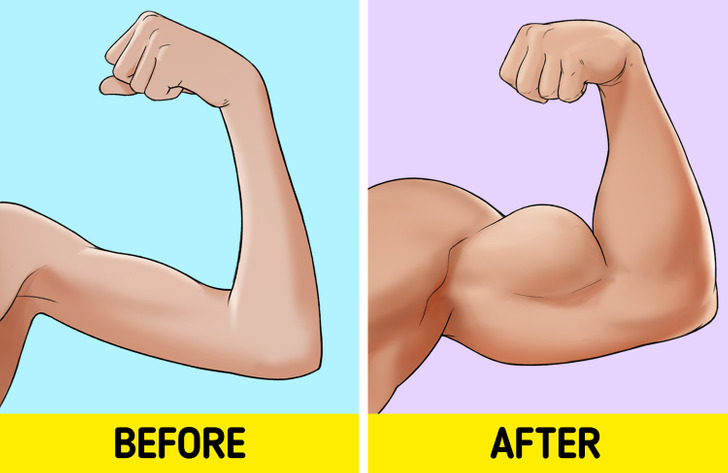
The muscles are actually cylindric fibers placed in a parallel position and when contracting, they create force. Our body constantly goes through cycles of renewal and proteins in our body are building up. Since the muscle needs proteins to grow, if you are not taking enough, you will lose its mass. Only by getting a sufficient amount of proteins will you be able to build new muscle tissue.
1. Make an exercise plan and train continuously.

This includes a number of repetitions, and it is a useful concept. When you are lifting weights be aware of how many times you repeat the exercise. For example, if you are lifting weights in the repetition of 1-5, you will develop more strength. Repeating the exercise 6-12 times can help you to build more muscle while 12-20 reps will elevate the muscular endurance and build muscles as well.
So, intensifying your training volume can get you to your goal and it is recommended to do lifting from 3 to 6 sets of 10-20 repetitions.
Note: The effective way for quickly building the muscles is to choose the weight which will make the repetition exercise so hard that it will be impossible to do more than 20.
2. Avoid overtraining
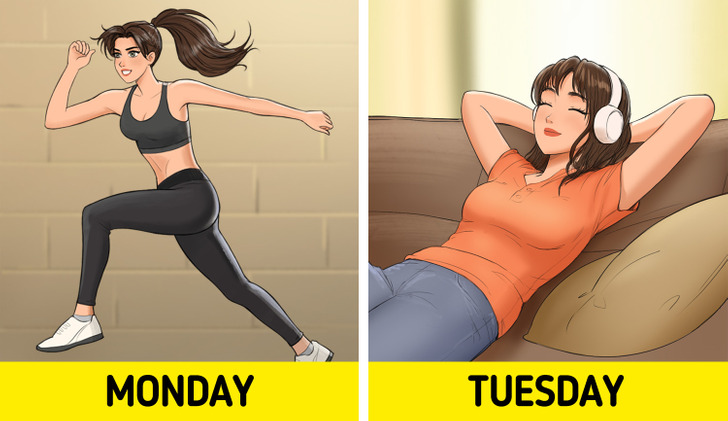
You need to choose the exercises made for a specific muscle that you want to build. For example, perform biceps curl or pullup for biceps, etc. You can include compound and isolation movements for building your muscle mass. Both types of exercise will help your muscles to grow.
- Compound exercises are different from isolation types as they target a variety of muscle groups and the other emphasizes the specific muscle. While doing the isolation exercises you are focusing on a particular muscle (e.g. leg press, standing shoulder press, etc.)
- Pay attention to having enough rest after the training. Overtraining can happen if you don’t let yourself recover and this can lead to some health issues. Always be sure to go within your limits and to have a pause between your workout days.
3. Plan your meals and include more protein in your diet.
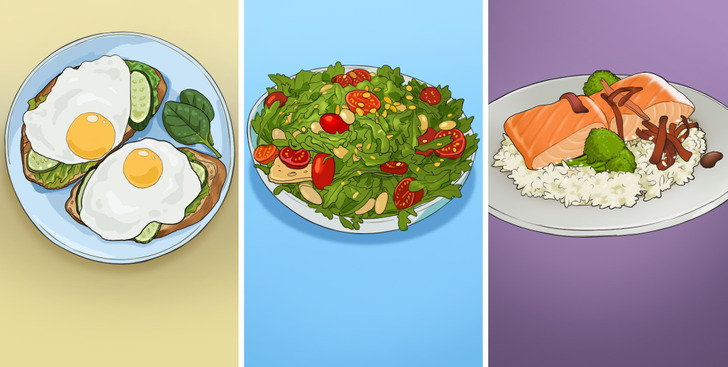
Most athletes and bodybuilders combine the bulking and cutting periods to gain muscles. During bulking you need to eat more calories than you burn while cutting cycles are more about decreasing the number of calories so the body fat doesn’t grow but training and eating in a way you don’t lose muscle.
What you need:
- Calories — include 300-500 calories more than you need in your daily intake. Your basic calorie needs depend on your gender, age, weight, height, and activity level. For women, the recommended daily intake is 2,000–2,400 (age 19 to 30), 1,800–2,200 (age 31 to 59) and 1,600–2,000 calories (age over 60). For men, it is slightly different — daily intake of 2,400–3,000 (age 19 to 30), 2,200–3,000 (age 31 to 59), and men over 60 need 2,000–2,600 calories per day. You can use this calculator for general information about your daily intake of calories, but it is advised to consult a health expert for precise information.
- Proteins — are crucial for building muscles. The best way to plan your protein meals is to consult with a registered nutritional expert. However, some researchers note that you should include 0.72 grams of protein per one pound (1.6 grams per kilogram) of your body mass in a day.
- Carbs — researchers have been advising recently that it is fine to take from 0.22 to 0.68 grams of fat per pound (that’s 0.5 to 1.5 grams per one kilogram) of your body mass in a day.
4. Food that will help you to build muscles.
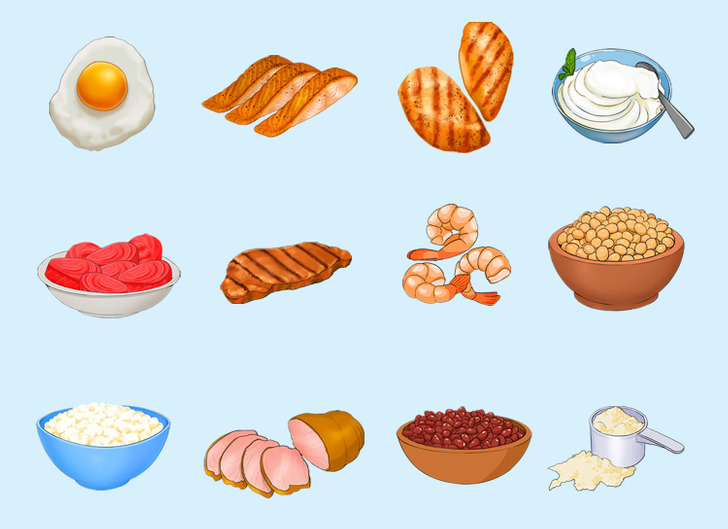
- Eggs — full of protein, healthy fats vitamin B, and choline.
- Salmon — is very good for your overall health as it contains proteins, omega-3 fatty acids, and important B vitamins.
- Chicken breast — include it in your diet as it is full of protein and can help you to lead an active lifestyle.
- Greek yogurt — an excellent snack as it contains a mix of fast and slow-digesting proteins.
- Tuna — it can boost your exercise performance because it has a high number of vitamins A, B (B12, niacin, and B6) as well as omega-3 fatty acids.
- Lean beef — you can choose this meat that will boost your muscle growth without feeding you with a bunch of calories. Beef is rich in proteins, vitamin B, minerals, and creatine.
- Shrimp — doesn’t have many calories but is packed with proteins and also amino acid called leucine.
- Soybeans — a great source of plant-based protein as well as unsaturated fats, vitamins, and minerals.
- Cottage cheese — you can get either the one with a high amount of fat or a low-fat version. This depends on how many calories you want to take in. It contains proteins also and leucine amino acids.
- Turkey breast — has a nice amount of proteins and a low amount of fat.
- Beans — there are many different kinds that you can include in your meals, like pinto, kidney, or black beans. They are a great source of proteins, B vitamins, and minerals.
- Protein powders — supplements can come in handy if you are not getting enough proteins from your regular diet. You can include powders like whey or casein.
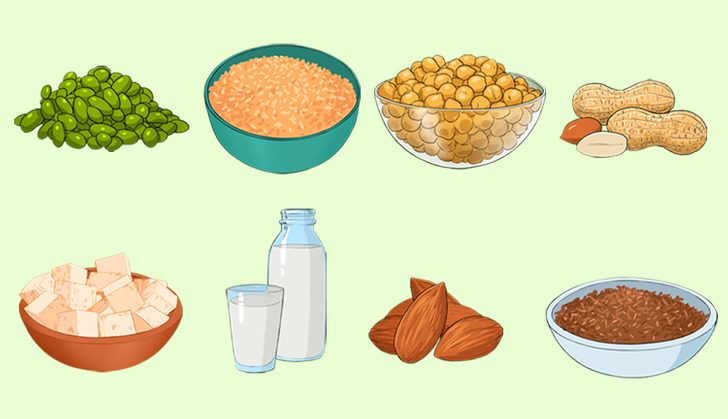
- Edamame — these immature soybeans contain proteins, folate, manganese, and vitamin K. Folate has an important role in helping amino acids get processed in the body.
- Quinoa — rich in carbs that will give you enough energy among others.
- Chickpeas — have carbs, protein, and fiber.
- Peanuts — are rich in different nutrients like unsaturated fat, and amino acid leucine among proteins and carbs.
- Tofu — is often used in a meal instead of meat. Contains proteins, fat, and carbs as well as calcium that helps the muscle function.
- Milk — another source of proteins, carbs, and fat and similar to cottage cheese has fast and slow-digesting proteins.
- Almonds — phosphorus can help your body process the carbs and fats into the energy that you need. Almonds have a fair amount of phosphorus, vitamin E, and magnesium but should be included in a diet carefully since they contain a high number of calories.
- Brown rice — packed with carbs that can boost your energy, help you exercise with higher intensity, and stimulate your muscle growth.
5. Get enough sleep.

Your body and muscles need time to rest and recover. It is recommended to get around 8 hours of sleep in order to recuperate. Also, during sleeping, the body lets out the human growth hormone that helps your muscles to get bigger.
6. Include supplements (optional)

So, to summarize — for maximum muscle growth you’ll need to consume more calories than you burn during exercising, include more proteins, and challenge your muscles by working out. Although you can grow your muscles in that way, adding supplements can help you to achieve your goals, too.
Here is the list of supplements that you can include in your diet:
- Creatine — the body produces it by itself so the muscles can have enough energy. Adding it can boost the creatine in your body which will help you to exercise harder and thus grow your muscle mass. Also, it has been researched considerably and meets the safety requirements.
- Protein supplements — the most popular ones are whey, casein, and soy protein. You can also find supplements that are derived from eggs, chicken, beef, etc.
- Weight gainers — are made in a way so you can consume both calories and proteins. Usually, people who have difficulties growing their muscles use these supplements.
- Beta-Alanine — this amino acid can help you to achieve better training and also can lessen exhaustion. It should be combined carefully with your exercise plan.